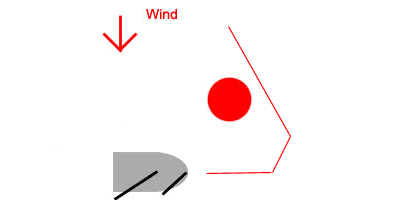Rounding Marks
In a Sailboat Race you will always end up rounding marks. These marks or buoys are called the windward mark, the gybe mark or the leeward mark.
In some races like on the Welsh Harp, there are more than just 3 marks and the whole thing gets far more complicated, however most marks on the course will still fit into one of these three categories.
So okay there are marks on the course, but how do I round them? What happens if I touch the mark? Why do some boats end up going much faster than me round the mark?
These are all questions that I will answer in this page.
First, how do you round marks. Well for every single mark you encounter in your boat racing career you will have to follow this same principle. The principle is, as Mark (no not the buoy, my helm!) often reminds me: Wide In, Tight Out (or WITO).
Wide In, Tight Out or WITO is THE principle that needs to be learnt when racing on a course as it will mean your mark roundings are smooth, crisp and most importantly fast.
The way you do WITO is by pointing at a place a little off the buoy (about a boat length) and then as you reach the mark you tighten up/bear away on a tight approach. This can be best explained with a diagram:

As you can see, the the boat approaches the mark slightly off the mark (Wide In) and then tacks around the mark staying very close to it (Tight Out).
Of course you don't want to be so close to the mark that you touch it. This answers the second question about what happens if you touch the mark. Usually you'll have to do a 360 turn out of the way of the fleet. of course it would be easier just to not touch the mark.
When you are out on the water next time, try and get some rounding mark practice using the above basic principles.
Right now, we are going to discuss why some boats end up going quickly when they round marks. Well what happens is that they put some heel on the leeward/windward side to help turn the boat.
This is similar to doing a roll tack, but in this case it is simply moving the boat in a different direction. Using your weight to change boat direction, is part of sailing without a rudder.
When you heel the boat like in roll tacking, you can get an extra punch of speed by pumping it slightly, by leaning out and balancing the boat again, forcing the centreboard into the water and giving you a kinetic boost of speed, which a great extra whilst boat racing in light winds or any winds for that matter.
Another way boats can overtake you is if you change WITO into TIWO (Tight In Wide Out). When you do this boats doing wide in tight out will manage to squeeze between you and the buoy, even if they don't have water.
This tactical manoeuvre is very common with novices getting overtaken by many boats by simply not rounding the mark properly.
Also by not being so close to the mark, you will not be able to get as high or low compared to the rest of the boats when you are on your next course, which is not very good at all in boat racing. For instance if you are on a beam reach to a mark that will make your beat, if you don't make the rounding tight enough, you will lose alot of ground on those who do tightly round the mark and gain upwards of half a boat length closer to wind.
And not only this, but you will be in their wind shadow, which is the worse possible place to be and you will have to tack behind them, which will slow you down and let them overtake you.
So in summary, follow WITO, which as a reminder is:
- W - Wide
- I - In
- T - Tight
- O - Out
Mark and I always have a 2 hour practice session before the main race in the afternoon. Try and do something like this to get your sailing up to scratch (especially with one week or more between sailing) and just to improve in non-competitive environments.
So follow WITO and your mark rounding will improve and you will be able to go faster and higher/lower than your opponents making the coveted first place in sight!
Return from Rounding Marks to Sailboat Race
Return from Rounding Marks to Started Sailing

